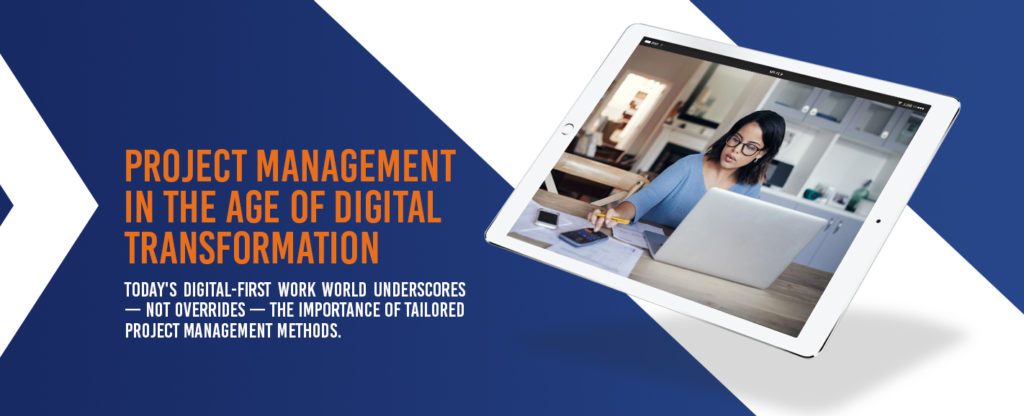Why We Love Project Management (And You Should Too!)

Only a third of company projects are completed successfully — that is, on time, on budget and delivering the full scope of outlined project expectations and functions. Only nine percent of organizations rated themselves as satisfied with how their planned projects yield continual strategic outcomes.
On the surface, this might read a little dismal. How could something so vital to a business as project planning and execution fall this short?
It doesn’t take a savant to look at these statistics and realize their potential. Perhaps it’s because project management is so vital to a business that its planning and execution — and everything in between — slips so easily under heavy scrutiny.
It’s time to reframe what we talk about when we talk about project management — its importance, its methods, its reasons for success and where project management trends and imperatives are heading. Plus, how your business can capitalize on it to foster teamwork and deliver success.
The Project Lifecycle: How to Manage a Project Effectively

Projects begin with an abstract question — how can we do X, solve Y, or simplify Z? Project management takes that question but scaffolds it, connecting individual parts and rungs until you’ve devised an actionable yet innovative ladder to solve a goal or problem.
In this sense, project management is both practical and conceptual, grounded in today but focused on tomorrow.
To realize this balance, companies set on improving project management effectively adopt two standard procedures — a project management methodology (PMM) and a template project lifecycle. Together, these two concepts take the ambiguity out of project management, positioning a company to act on and execute its every idea.
1. What Is Project Management Methodology?
PMM is your organization’s shared understanding of how to approach projects. As its name suggests, it becomes the guiding principles behind project management and a substantial part of the organizational structure.
Every company’s project management methodology will be slightly different because every work culture is different. Yet in implementing a PMM, you reduce the likelihood of role uncertainties, inconsistencies, and departments coming up with inharmonious, individual ways to plan and pitch a project. This is because PMMs set:
- Project values: What sorts of projects are valuable to the organization as a whole? Which align with our mission, values and feasible resources?
- Project expectations: How many new projects can we, as a company, take on, and when? Who do we want our projects to serve ultimately?
- Project personnel: Who is involved in project planning and pitching? Who should sit at the table at these meetings?
- Project items: What does our work culture say we bring to an actual project pitch? This includes documents, business cases, presentations and more.
2. What Is the Project Lifecycle?
While PMM provides a culture and an awareness of how projects get rolling, the project lifecycle is the actual steps taken to draft and execute a project. In other words, the project lifecycle is the standard, repeatable and consistent template to follow when implementing a new initiative.
Like the PMM, a project lifecycle is known and practiced across the organization. This means projects go through the same steps, the same strategic measurements, and the same standards no matter where they originate — and they are more likely to succeed since they follow meticulous planning.
The project lifecycle is broken down traditionally into five phases:
- Conception: In phase one of project management, the abstract project is presented in a project charter or project initiation document (PID). These documents are your opening case. They provide the momentum to your idea, stating what it will solve, who it will involve and why it’s essential. If key stakeholders agree to it, you graduate to phase two.
- Perimeter planning and definitions: Phase two allows you to preemptively and methodically look ahead. It outlines the project’s proposed budget, key parts, and core timelines, plus a representation of those components in action. It also formally pulls together all project participants, with each receiving the plans you’ve meticulously outlined. You now have your project roadmap.
- Project launch: Phase three is where you put your project into action. Set up a status or project tracker using project management software or a simple spreadsheet. Monitor the roles and resources defined in stage two and hold status meetings to communicate any updates and modify plans as needed.
- Performance controls: Stage four is where you put numbers to your project. Since the project is now well underway, you can begin to quantify key performance indicators (KPIs) like budgets and timetables, but also less apparent numbers like costs associated with unexpected risk mitigation or lag times between project workflows. Actively monitor these KPIs through the fulfillment of all workflows in the project tracker and into phase five.
- Project conclusion: Stage five provides the structure to successfully close-out the project and review your project tracking. While the tasks behind the project are done, it’s now time to qualify all that work. Round up the scope and scale of the project in a “post-mortem” — a meeting to review and celebrate the accomplishment. Acknowledge key team players and evaluate the project’s value using phase four’s KPIs, as well as what worked well and what can be improved next time. Write and file a complete project report.
Project Management and the Growth of Your Business
Project management is about well-planned pieces fitting together to form a future, collaborative goal. When broken down through the lifecycle, project management is a set of process steps by which any employee, manager or an entire department can outline, execute and accomplish value-based goals.
There are so many benefits when your company follows this formula. Rather than increasing red tape or creating bureaucratic lanes, incorporating project management into your projects empowers employees to work toward tangible goals, learn new skills and contribute to institutional progress.
1. The Financial Value of Project Management
Much of the attention and support for project management improvements across an organization come down to financial value and what these improvements can mean for your bottom line.
From an organization’s vantage, there are few strategies as cost-competitive, practical or profitable as standard project management procedures, namely through a set project lifecycle template and understood PMM. In all, improved project management can provide financial incentives across the following:
- Make smarter budget allocations: Over a third of executives in The Economists’ Intelligence Report said project management improvements allowed them to more diligently review project risks and benchmarks, which then gave better quantitative and qualitative understanding into what makes a project succeed. That, in turn, allowed them to allocate project resources better the next fiscal year.
- Cut costs: Employing more strategic project management software and creating reusable, enterprise-wide project lifecycle templates transforms operating costs from reactive to the proactive. You save time and money by decreasing project start-up times, reducing team members’ learning curves and eliminating redundant processes or template reinventions.
- Create a leaner project portfolio: Projects are ideated across the enterprise but follow the same standard planning and execution procedures. Across the organization, project management is cohesive and understood.
2. Project Management Framework for Success
Yes, successful project management means projects delivered on time and on or under budget. Yet it can do so much more.
Many organizations adopt additional frameworks and strategies to amplify their project-management PMMs and life cycle templates — with holistic enterprise growth as the ultimate goal. These frameworks include dedicated project management offices and continuing education programs.
Project Management Offices (PMOs)
More and more, organizations are funneling their project-management efforts into set bodies known as project management offices. These offices are in charge of reviewing project proposals to ensure best practices and strategic, value-based alignment across their entire project portfolio.
They can be formal or informal and can exist in each department or as a single, cross-organization board. Either way, PMOs deliver serious results. Organizations with PMOs cite the following advantages:
- Lowered failed-project rates by 31 percent
- Brought in 30 percent of projects under budget
- Boosted productivity by 21 percent
- Delivered nearly 20 percent of projects ahead of schedule
- Saved their companies an average of $567,000 per project
Mentoring and Education
Continuous improvement and the quality of PMM rests with an organization’s employees. They are the ultimate harbingers of success.
As such, employees and managers alike require continued support to ensure that PMM culture implementation, project management workflow best practices and cross-department relevant lifecycle templates are understood and embraced. Project-management continuing education and mentoring programs focus on how to manage a project effectively across the lifecycle, as well as sets up internal structures for a project maturity model that can be continually refined and enhanced.
Project Management in the Age of Digital Transformation

Today’s digital-first work world underscores — not overrides — the importance of tailored project management methods. Strategic digital tools and resources used across the organization are, in large part, part of the formula of PMM and lifecycle template success, often providing their framework.
Indeed, the value of project management grows when considering all the ways technology and innovation complement more effective project management:
- Communication channels have blossomed: There are more ways than ever to stay connected. In the workplace, project management and collaborative team applications or software open up new ways to converse, catalog and exchange information. Communications traditionally siloed by in-person meetings and email chains are unlocked using cloud and web-based technology, letting the team communicate whenever, wherever.
- KPIs and “big” data are unleashed: Project monitorization and performance metrics have never been easier to gauge. Technology allows those projects already implemented to be monitored and analyzed using custom KPIs, while projects in process can be robustly cataloged and tracked for what’s working and what isn’t. All this quantitative data today stands to improve project management decisions tomorrow.
- Results can be replicated: With the help of technology, enriched data benchmarks and the abundance of project-tracking resources, successful initiatives can be replicated at scale. You can seamlessly iterate models that work and avoid those that don’t.
- Quality of services is enhanced: Quality control means you’re producing valuable goods or services time and time again. Digital project-management tactics directly influence consistency, since they allow compatible and repeated processes across the organization — all backed by data.
Project Management Across Industries
Every industry seeks ways to refine how information is gathered, constituents communicate, tasks are prioritized, and valuable work is done. These are hallmarks of how a business defines itself — and how it manages its project portfolio.
The following industries stand out in particular for the efforts and attention they place on effective project management. When successful, they not only revitalize who does what work, when and how, but also hold a broader influence on project management methods themselves.

Project Management for Government
The government sector faces some of the tightest external expectations — often with similarly tight internal resources. Tasked with dozens of responsibilities designated to critical departments, from operations in education and economic policies to transportation, health and public safety all rest on the ability to keenly prioritize today’s needs while predicting tomorrow’s problems — all while staying in budget.
Enhanced project management for the government sector includes the following benefits:
- Strategic operational efficiencies: Improved project management allows the public sector to do more with what they already have. Rather than start from scratch or disrupt current systems, departments can work smarter, not harder.
- Executive project strategy: Aligned project management approaches and resources across agencies, bodies, and departments allow for more effective accomplishment of initiatives.
- Improved resource allocation: Financial and non-financial assets can be used more effectively. Government staff across the board work in a streamlined, productive system where their impact can be felt and seen, while budget and capital resources are put to data-backed best use.
1. Project Management for IT
IT departments stand at the center of effective project management. Under IT’s helm, organizations implement the very tools and resources that make PMMs and standard project management lifecycles actionable.
Because of this, many project management methodologies have emerged primed for IT operations. Models like Agile and DevOps have become household names to address project management barriers in IT, getting more done through harmonized, tech-first principles and processes.
Project management for IT can:
- Mitigate risks and bolster risk assessments: Data-driven decision making means IT departments can avoid past pitfalls and map project decisions, particularly with initiatives involving hardware or software migrations and integrations.
- Improve transparency and accountability: Even in fast-paced, multi-branch IT departments or large tech-driven companies, improved project management means everyone has a clear understanding of who does what, when and how — but more importantly, that it all ties together.
- Decrease expenses: IT departments can be notorious for under-scoping projects. Project management best practices provide the resources and structure to stay on track with timelines, budgets, and value-based deliverables, decreasing overall project expenses.
2. Project Management for Nonprofits
The nonprofit sector is in a singularly unique position when it comes to project management. By definition, these organizations exist to usher projects into fruition, creating and implementing initiatives often for the greater good. Yet many face impediments to the size and scale of projects they can deliver due to internal and external operational limitations.
Improved project management strategies can help nonprofit organizations in the following key ways:
- Understand their organizational maturity: Project maturity models allow nonprofits to grasp the parameters of their current resources — then surpass them, better maximizing time, talent and resources.
- Amplify core operations: Things like fundraising and mission-driven event planning are imperative to a functional nonprofit. Strategic project management models build smoother pipelines for these events’ success.
- Showcase impact: Annual reports and similar impact analyses prove the fruits of a nonprofit’s labor. They lie at the heart of these organizations and showcase their importance. Simply put, tailored project management strategies sharpen an organization’s ability to highlight their impact, both in quantifiable and qualifiable ways.
Deliver Success, Foster Teamwork — Build Momentum for Your Organization’s Project Management

Improved project management is a marathon, not a sprint. Momentum, Inc. helps see you to the finish line.
We’ve provided premium, multi-tiered project management services to a range of clients, tailoring plans and best practices from PMM and PMO development through ongoing project management mentorship programs. Through our project management partnership, you sharpen your ability to take projects from abstractions to actualities — driving growth along the way.
See Momentum’s Project Management service portfolio for yourself, or reach out to one of our representatives today.
 Tap to email
Tap to email
